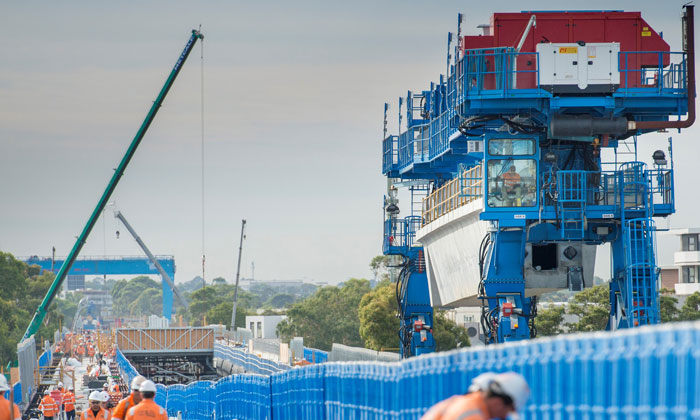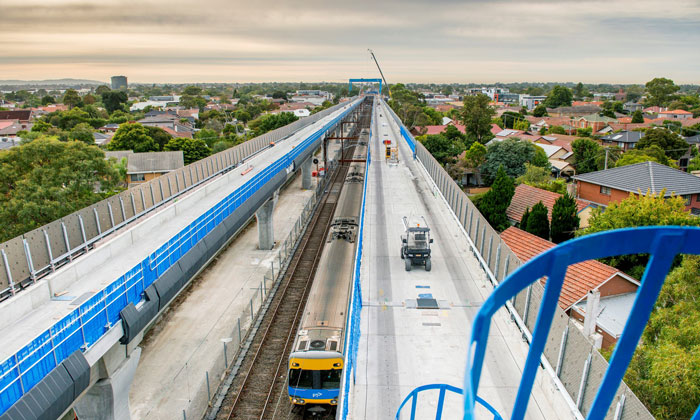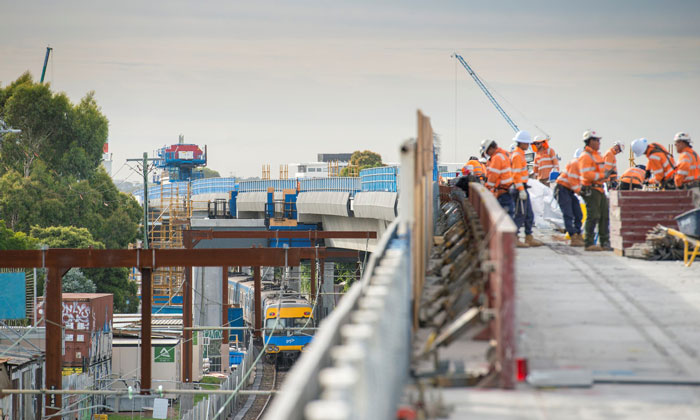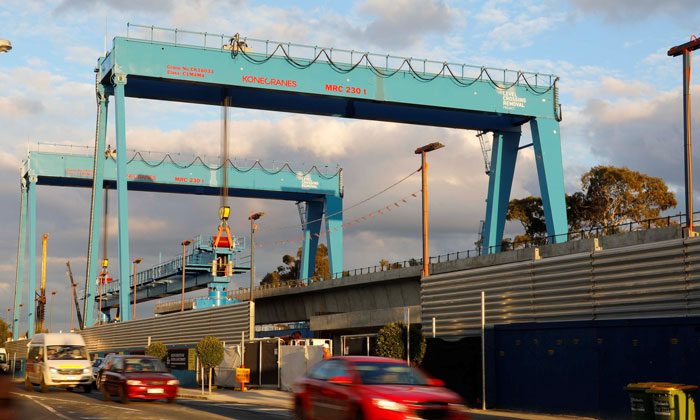Australian first rail straddle carrier completes operation on level crossing removal project
Posted: 19 April 2018 | Global Railway Review | No comments yet
The Caulfield to Dandenong level crossing removal project in Melbourne, Australia, recently reached the end of a crucial phase of construction. As part of the project to remove nine level crossings on the Cranbourne/Pakenham line in south east Melbourne, large-scale specialist machinery successfully completed a final section of elevated rail deck.


An intensive logistical exercise contributed to this achievement, involving the first ever Australian use of a straddle carrier and gantry crane configuration in a live rail corridor. The specialist equipment was used on one specific section of elevated rail that will remove four crossings at Carnegie, Murrumbeena and Hughesdale.
Since May 2017, thousands of hours have gone into the process of building, lifting and shifting a total of 174 bridge spans – each ranging from 280 to 420 tonnes. During this time, the giant carrier travelled more than 260km back and forth along the rail line.


The Caulfield to Dandenong Level Crossing Removal Project is being delivered by an alliance consisting of Lendlease, CPB Contractors, WSP, Aurecon, the Level Crossing Removal Authority (LXRA) and Metro Trains Melbourne (MTM)
Alliance Construction Director, Simon Barnes, is taking no small amount of pride in what his team has achieved: “This project leaves an important legacy – not only to the community, but to industry,” he says. “We have taken a construction technique usually associated with long viaducts built through open terrain and successfully – and safely – applied that to an Australian residential environment. Adapting and evolving that technique to a local suburban environment has led us to form relationships with engineering experts around the world.”
The new skills, processes and protocols associated with this national first have entailed an extensive amount of behind the scenes activity, including a comprehensive training programme.
Simon explains: “We’ve trained approximately 300 workers to operate the carrier, gantry cranes and support beams, as well as cast and tension the spans that make up the rail deck. It’s not insignificant from an industry perspective as we will retain this knowledge in Australia along with a whole range of highly transferrable skills.”
The Caulfield to Dandenong Level Crossing Removal Project is being delivered by an alliance consisting of Lendlease, CPB Contractors, WSP, Aurecon, the Level Crossing Removal Authority (LXRA) and Metro Trains Melbourne (MTM). As a consortium, this group is working to remove nine level crossings on the Cranbourne/Pakenham line in Melbourne’s south east, constructing a raised rail line set to create 22.5 hectares of new public open space.


Approximately 300 workers were trained to operate the carrier, gantry cranes and support beams
Elevated rail is a relatively new way of removing level crossings in Melbourne and the project has attracted its share of controversy. However, with the design concept now close to being realised, the project has garnered increasing support from the wider community.
Simon adds: “We are really looking forward to the community fully experiencing and appreciating our vision. Once the land is opened up, people will be able to walk freely around and under the elevated line – that will be a game-changer for suburbs that have been divided for as long as anyone can remember.”
From concept to implementation
The concept of using a straddle carrier and launching a beam system was devised during the bid phase to help solve the challenge of the narrow rail corridor between Caulfield and Hughesdale.
In many sections there simply wasn’t enough room to use conventional cranes without closing the rail line – which happens to be Melbourne’s busiest – for extended periods of time.
Thinking outside the box, the project team custom-designed equipment, materials and methodology to allow construction to continue parallel to existing tracks and with minimal disruption to commuters.
How it worked
Two gantry cranes were based at a static assembly area close to Murrumbeena Station. These cranes assembled concrete segments into spans of up to 40m and lifted them onto the elevated rail deck.
Shuttling back and forth along the expanding rail deck to pick up these spans and transport them in to position, the straddle carrier also installed the spans with the help of a 94m-long support beam.
Innovation and safety
While the straddle carrier/gantry crane combination is a tried and tested construction technique commonly seen on high-speed rail projects in Asia, this Australian application had a notable difference. Here, construction took place in a narrow rail corridor through residential suburbs – in some places only 5.5m away from fences.


The project team custom-designed equipment, materials and methodology to allow construction to continue parallel to existing tracks and with minimal disruption to commuters
When it came to ensuring resident, worker and commuter safety, innovation proved key. The straddle carrier was fitted with the latest cable guidance technology, designed to prevent the carrier from deviating left or right and ensuring it moved with precision along the elevated rail deck.
The span assembly approach also differed from industry norms. Instead of lifting individual segments onto the rail deck and assembling the span in the air, the concrete segments were stressed together using steel cables on the ground. This limited the amount of time the crew spent working at heights and enabled all safety checks to be completed before the span was lifted.
A notable – and visible – achievement
Recently, members of the community looked on as the last beams were lowered into place and the straddle carrier was lifted off the deck and dismantled. The 30m-high gantry cranes, which have loomed above the Murrumbeena skyline for many months, are being taken down piece by piece.
Sustainability footprint
With biofuels showing versatility in increasingly larger scales of application, the project team engaged supplier Green Power Solutions to investigate ways that cleaner burning fuels could be put to use powering the gantry cranes.
The result was a 70 tonne reduction in carbon emissions, thanks to a carefully optimised biodiesel mix used in combination with a premium 550KVA Scania generator. The biodiesel component within that mix consisted largely of recycled vegetable oil, sourced from a food manufacturing plant in Melbourne’s north.
Click here to learn more about the Melbourne’s level crossing removal project.
Related topics
Infrastructure Developments, Level Crossings, Route Development, Safety








